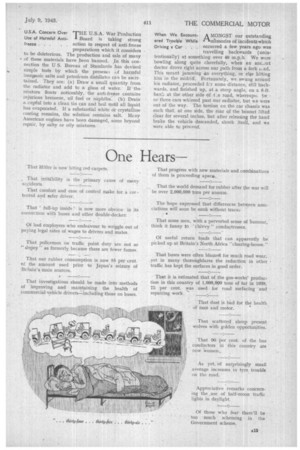Passing Comments
Page 14

Page 15

If you've noticed an error in this article please click here to report it so we can fix it.
I T is several weeks now since the ma.nceuvres that gave the South and the Midlands a foretaste of mechanized warfare were concluded. At the time, at any rate in certain districts, petrol cans were discarded wholesale by the troops and left to lie in the ditches and hedgerows. Some have since been removed by thrifty rustics for their own purposes, but others still remain asrusty relics of a hectic week. Very possibly the cost of salvaging them would hardly have been justified, but the sight of them is hardly calculated to encourage the local public to save more tin, and it seems curious (at any rate to the layman) that this act of apparent waste was ever permitted. in the first place. It is difficult to imagine any adequate excuse for it. Waste or Army Petrol Cans is Discouraging Salvage
U.S. Tyre Company's A MERICAN tyre manufacChairman Gives Views r-kturers should know some. on Synthetic Rubber . thing about the rubber . position. A few weeks ago the chairman of the Goodyear concern predicted that his nation's tyre difficulties would be eased considerably ,by midsummer, 1944. By then, he said, syntheticrubber production would have got into its stride, as it is steadily gaining momentum. The difficulties in the process are being eliminated by chemists and
engineers, niany of whom were trained in rubber technology by the tyre• companies years before the war.' His company is building four large synthetic plants, which will produce from butadiene, supplied by the Government from other plants. The capacity of each will be from 30,000 to 120,000 tons annually. He believed, however, that there would be a return to natutal rubber after the _war, '.'cause it will, most probably'. be cheaper. •
ADAIRY farmer, who is under contract to convey milk for the Milk Marketing Board, recently applied for a permit to purchase a larger and more suitable lorry
for the job. His application was referred to the D.T..0. for investigation, and this officer, in discussing the niatter with the applicant, stated that he thought it would be better to allow hiin more petrol than to give him a permit for a bigger vehicle. Each return journey is 20 miles and, apart from waste of petrol and rubber, the driver (the farmer himself) is caused to work late in the evening doing. extra journeys; namely, four single journeys instead of two. Apart from his activities with the milk he farms 50 acres, and the extra driving imposed upon him naturally leaves little or no time to deal with his land.
An Official View on Attaining Fuel
Economy
THE U.S.A. War Production Board is taking strong action in respect of anti-freeze preparations which it considers to be deleterious. The production and sale of many e of these materials have been banned. In this connection the U S. Bureau of Standards has devised simple tests by which the presen“ of harmful inorganic salts and petroleum distillates can be ascertained. They arc: (a) Draw a small quantity from the radiator and add to a glass of water. If 'the mixture floats noticeably, the anti-fre,eze contains injurious kerosene, oil fuel or naphtha. (b) Drain a cupful into a clean tin can and boil until all liquid has evaporated. If a substantial white or crystalline coating remains, the solution contains salt. Many American engines have been damaged, some beyond repair, by salty or oily mixtures
U.S.A. Concern Over Use of Harmful Anti..
Freeze . . .
MONGST our outstanding r-Imemories of incidents which occurred a few years ago was travelling backwards .(unintentionally) at something over 40 m.p.h. We were bowling along quite cheerfully, when an ancanit doctor drove right across our path from a fork 1, ad. This meant jamming on everything, or elge hitting him in the midriff. Fortunately, we swung around his radiator, proceeded fer some distance, still backwards, and finished up, at a steep angle, on a 6-ft. ban:: at the other side of f e road, whereupo. tw or three cars whizzed past our radiator, but se were out of the way. The torsion on the car chassis was such that, at one side, the rear of the bonnet lifted clear for several inches, but after releasing the hand brake the vehicle descended, shook itself, and we were able to proceed. When We Encountered Trouble While Driving a Car . . .




















































